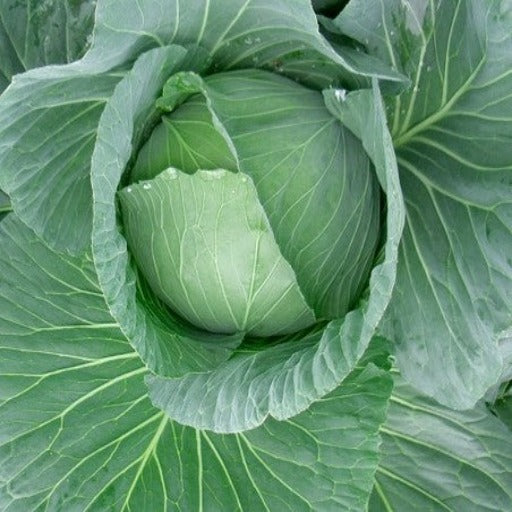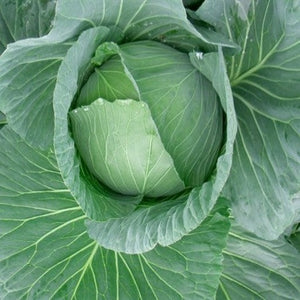- Hardiness Zone: 3-12 Biennial Typically Grown As An Annual
Seed Depth: 1/4 inch
Seed Spacing: 12–18 inches
Row Spacing: 18–24 inches
Sunlight: Full sun to partial shade
Days to Sprout: 7–10 days
Days to Maturity: 65–75 days
Growth Habit: Compact, Upright
Sunlight: Choose a location that receives full sun for at least 6-8 hours a day. Cabbage thrives in cooler temperatures but requires plenty of sunlight for optimal growth.
Soil: Prefers well-drained, fertile soil with a pH between 6.0 and 7.5. Amend the soil with compost or well-rotted manure to enhance fertility and drainage. Cabbage is a heavy feeder, so nutrient-rich soil is essential for healthy growth.
When to Plant: Golden Acre Cabbage is a cool-season crop that can be planted in early spring or late summer for a fall harvest. Start seeds indoors 6-8 weeks before the last expected frost date in spring, or sow seeds directly in the garden as soon as the soil can be worked. For a fall crop, sow seeds in mid-summer.
Starting Indoors: Sow seeds 1/4 inch deep in seed-starting mix. Keep the soil moist and maintain a temperature of 65-75°F (18-24°C). Transplant seedlings outdoors when they are 4-6 inches tall and the danger of frost has passed.
Direct Sowing: Sow seeds directly in the garden 1/4 inch deep and 12-18 inches apart in rows spaced 18-24 inches apart. Thin seedlings to 12-18 inches apart once they are a few inches tall to allow enough space for the heads to develop.
Succession Planting: Sow every 2–3 weeks for a continuous harvest.
Watering: Keep the soil consistently moist but not waterlogged. Water cabbage regularly, especially during dry periods, to ensure even moisture. Water at the base of the plant to avoid wetting the foliage, which can lead to disease.
Fertilization: Cabbage is a heavy feeder. Apply a balanced fertilizer or compost at planting time. Side-dress with compost or a balanced fertilizer when the plants are 3-4 weeks old and again when they start to form heads.
Mulching and Weeding: Apply a layer of mulch around the plants to retain soil moisture, suppress weeds, and keep the soil temperature consistent. Mulch also helps to prevent the soil from splashing onto the leaves, which can reduce the risk of disease. Hand-pull weeds carefully to avoid disturbing the shallow roots of the cabbage.
Pruning: Remove any yellowing or damaged leaves to maintain plant health.
Pest and Disease Management: Cabbage can be susceptible to pests such as cabbage worms, aphids, and flea beetles. Use row covers to protect young plants and organic pest control methods like neem oil or insecticidal soap if necessary. Practice crop rotation and ensure good air circulation to prevent fungal diseases like black rot and clubroot.
When to Harvest: Golden Acre Cabbage is typically ready to harvest 65-70 days after planting. Harvest when the heads are firm and reach 4-6 inches in diameter.
How to Harvest: Use a sharp knife to cut the head from the base of the plant, leaving the outer leaves intact. These outer leaves can help protect the cabbage head during storage. After harvesting, you can leave the stalk in the ground to see if it will produce a secondary, smaller head.
Storing Fresh Cabbage: Freshly harvested cabbage can be stored in the refrigerator for up to 2 weeks. Place the head in a plastic bag or wrap it in a damp cloth to retain moisture. For longer storage, cabbage can be stored in a cool, dark place or fermented into sauerkraut.
Why You’ll Love It
Golden Acre Cabbage is an early-maturing heirloom beloved for its compact size, uniform shape, and deliciously sweet flavor. Perfect for small gardens, raised beds, or succession planting, these cabbages form firm, 3–5 pound heads on short stems. They’re excellent for fresh use and cook up beautifully in everything from cabbage rolls to sautés. Great for gardeners who want dependable results and a fast harvest.
Plant Characteristics
Height: 12–18 inches
Growth Habit: Compact rosette with round central head
Head Type: Tight, green, globe-shaped heads, 3–5 pounds
Days to Maturity: 60–65 days
Hardiness: Cool-season biennial grown as an annual
Flavor and Culinary Uses
Flavor: Mild, sweet, and crisp with tender inner leaves
Culinary Uses: Great for coleslaw, cabbage rolls, soups, stir-fries, and steaming. Holds texture well when cooked and stores nicely in the fridge.
Companion Planting Tips
Good Companions: Beets, onions, celery, chamomile, and dill
Avoid Planting Near: Strawberries or other cabbage-family crops that share pests
Bonus Benefit: Compact habit makes this variety ideal for tighter garden spaces and raised beds
Common Issues and Solutions
Split Heads: Harvest promptly when firm and mature to prevent cracking from rain or overwatering
Cabbage Loopers or Worms: Use row covers early and hand-pick pests — beneficial insects like parasitic wasps help naturally
Stunted Growth: Space plants properly and enrich the soil with compost before planting
Seeds Per Packet
| 1g | Approximately 240 |
| 3g | Approximately 720 |
| 5g | Approximately 1,200 |
| 7g | Approximately 1,680 |
Why You’ll Love It
Golden Acre Cabbage is an early-maturing heirloom beloved for its compact size, uniform shape, and deliciously sweet flavor. Perfect for small gardens, raised beds, or succession planting, these cabbages form firm, 3–5 pound heads on short stems. They’re excellent for fresh use and cook up beautifully in everything from cabbage rolls to sautés. Great for gardeners who want dependable results and a fast harvest.
Plant Characteristics
Height: 12–18 inches
Growth Habit: Compact rosette with round central head
Head Type: Tight, green, globe-shaped heads, 3–5 pounds
Days to Maturity: 60–65 days
Hardiness: Cool-season biennial grown as an annual
Flavor and Culinary Uses
Flavor: Mild, sweet, and crisp with tender inner leaves
Culinary Uses: Great for coleslaw, cabbage rolls, soups, stir-fries, and steaming. Holds texture well when cooked and stores nicely in the fridge.
Companion Planting Tips
Good Companions: Beets, onions, celery, chamomile, and dill
Avoid Planting Near: Strawberries or other cabbage-family crops that share pests
Bonus Benefit: Compact habit makes this variety ideal for tighter garden spaces and raised beds
Common Issues and Solutions
Split Heads: Harvest promptly when firm and mature to prevent cracking from rain or overwatering
Cabbage Loopers or Worms: Use row covers early and hand-pick pests — beneficial insects like parasitic wasps help naturally
Stunted Growth: Space plants properly and enrich the soil with compost before planting
Seeds Per Packet
| 1g | Approximately 240 |
| 3g | Approximately 720 |
| 5g | Approximately 1,200 |
| 7g | Approximately 1,680 |






Share and get 15% off!
Simply share this product on one of the following social networks and you will unlock 15% off!